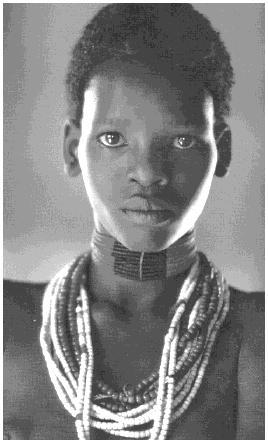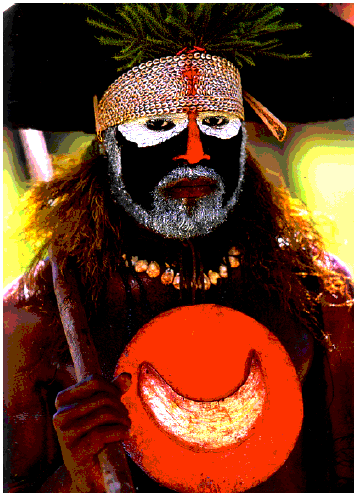On Earth
Eric Meola,
Photographer
(Graphis/
Watson-Guptill)

Skeletal trees before the sun setting into the wisps of Lake Karibga. Masks --- Meola is much taken with dozens of colorful masks (fifteen, to be exact) to be found in New Guinea and Ethiopia, as with the dancers of Kenya and the women of Namibia, who "coat their bodies with butterfat and ochre."
But yet we must ask: How can one "review" a perfectly set, perfectly colored, perfectly laid out series of photographs from all over the world (no margins, no words in reverse burn, no page numbers). Unless you have the panache of Anthony Lane, James Agee or Pauline Kael (on movies), Edmund Wilson, H L Mencken or Lolita Lark (on novels) --- how can any reviewer be expected to tell you the good or the bad of such a plethora of yummy photographs?
The only thing I can do is to warn you of two things about The Last Places on Earth.
 If you want ugliness or stink or bodily fluids, you'll have to seek them elsewhere. No matter where they are from these animals and people are clean, pretty, beautiful. Some are pretty bizarre --- those masks! --- but all are quite lovingly lovely. No cripples, poverty, hunger, disease allowed.
If you want ugliness or stink or bodily fluids, you'll have to seek them elsewhere. No matter where they are from these animals and people are clean, pretty, beautiful. Some are pretty bizarre --- those masks! --- but all are quite lovingly lovely. No cripples, poverty, hunger, disease allowed. At $60, you'll be paying (approximately) $1.70 per lovely face, mask, animal, or sunset. Which is probably worth it if you can figure out how to take these pictures out from behind their covers and lay them out for all to see.
Note: The two photographs we have reproduced here are lousy copies of quite nice originals. After all, our Canoscan scanner ("Canoscan." Like a can-opener) can only do 300 dna's or cip's or iou's or whatever they are called. It is pretty crude.
We are reminded of photographs of the paintings at the Barnes Foundation that were reproduced by the good Doctor Albert Barnes in his 1928 book, The Art in Painting. He knew that no reproduction could ever come close to the glory of the original, so he threw in these tiny black-and-white snapshots here or there just to tempt you to seek out the originals, or, if you were an "art critic" --- he loathed art critics --- make you feel bad that he wouldn't let you in the massive, heavy door of his huge Impressionist museum at Marion, Pennsylvania.